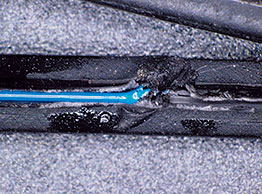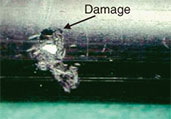 |
|||||
|
|
|||||
|
Practical Field Information about Telecommunication Technologies Vol. 9, No. 6, pp. 48–52, June 2011. https://doi.org/10.53829/ntr201106pf1 Fault Cases and Countermeasures against Damage to Access System Facilities Caused by WildlifeAbstractWildlife that damages access system facility is classified into three groups (rodents, insects, and birds). We have investigated the types of damage and have studied countermeasures. Such countermeasures will contribute greatly to reducing maintenance costs and improving the reliability of access system facilities. This article is the fifth in a bimonthly series on the theme of practical field information about telecommunication technologies. This month’s contribution is from the Access Engineering Group, Technical Assistance and Support Center, Maintenance and Service Operations Department, Network Business Headquarters.
1. IntroductionMost of the access system facilities maintained by the NTT Group are exposed to the outside environment. This means that damage caused by rain, wind, lightning, and other natural phenomena can occur. In addition, more than a little damage is caused by wildlife. In this article, we report on the various kinds of damage due to wildlife and countermeasures to maintain the reliability of access system facilities in Japan. 2. Fault casesAccess system facilities between a central office and customer premises along with various kinds of wildlife that cause damage are schematically illustrated in Fig. 1. Wildlife that causes damage to access system facilities in Japan can be broadly classified into (1) rodents (squirrels, flying squirrels, rats, etc.), (2) insects (moth larvae, cicadas, ants, etc.), and (3) birds (crows, woodpeckers, etc.). These kinds of wildlife can be found throughout the country.
Most rodents are active all year (only a few hibernate), so the time when damage happens is not limited to a particular period. They mainly damage cables, especially small-diameter ones. The degree of damage and the time that damage happens depends on the type and ecology of insects: moth larvae damage cables in early summer (June and July) before they become chrysalises, and cicada damage is caused specifically by adult females mainly from early summer to early fall (June to September). Damage caused by birds mainly occurs during the breeding season. In particular, crows can cause extensive damage in the period from March to June. 2.1 RodentsRodents have incisors on both upper and lower jaws. These teeth continue to grow throughout their life, but rodents keep them to an appropriate length by gnawing on objects. Rodents can be broadly classified into the Sciuridae family that includes squirrels and flying squirrels and the Muridae family that includes black rats and house mice. They chew on telecommunication cables and connection closures and damage copper wires inside metallic cables and fibers inside optical cables. Damage caused by members of the Sciuridae family frequently occurs along aerial cable routes in mountainous areas and damage caused by members of the Muridae family often occurs in underground cable routes. An example of optical fiber cable damage (by a flying squirrel) is shown in Fig. 2, a flying squirrel encountered in an area in which damage occurred is shown in Fig. 3, damage to a fiber free access (FFA) closure (by a squirrel) is shown in Fig. 4, and a squirrel’s incisor scars (upper and lower) are shown in Fig. 5.
2.2 Insects2.2.1 Moth larvaeMoth larvae burrow into trees and the ground and live in holes. The larvae mistake telecommunication cables for plants. As a result, they can damage the cable by chewing. An example of damage to an optical fiber cable (by a moth larva) is shown in Fig. 6.
2.2.2 CicadasCicadas generally lay their eggs in dead trees, avoiding living trees that might freeze over during the winter. They may also try laying their eggs in a drop cable by piercing the sheath with the ovipositor. This behavior can damage an optical fiber inside the cable. Cicada egg laying, cicada eggs, and damage to a drop cable (by a cicada) are shown in Figs. 7–9.
2.2.3 Other insectsOther insects like ants and bees may invade connection closures or cable conduits through very small gaps to build nests. This kind of activity can damage facilities, and there are examples of centipedes invading outdoor access system equipment and getting burned up by coming into contact with package terminals. Centipedes prefer tight spaces and can invade equipment through small gaps such as cable entryways. A centipede found inside an outdoor remote subscriber module is shown in Fig. 10.
2.3 Birds2.3.1 CrowsIn the breeding season before summer, a pair of crows will build a nest by gathering slim, sturdy materials like twigs or wires. During this time, these crows may use their beaks to bite around a drop cable’s water-draining section (where the supporting wire separates from the optical fiber section) and damage the optical fiber inside the drop cable. An example of damage to a drop cable (by a crow) is shown in Fig. 11.
2.3.2 WoodpeckersWoodpeckers engage in drumming (knocking on a tree trunk with their beaks) to prey upon insects or to assert territory or mating rights. They may also do this on telecommunication cables, opening up holes in the sheath and damaging copper wires. An example of damage to a metallic cable (by a woodpecker) is shown in Fig. 12.
3. Countermeasures3.1 RodentsOne method for preventing the problem introduced above is to use high-strength-sheath cable that has an internal stainless-steel layer. Another effective method for preventing partial cable damage is to use a squirrel-proof cover or squirrel-proof tape (both have a layer of stainless steel affixed to a PVC (polyvinyl chloride) sheet). Connection closures can be protected by commercial protective covers. A high-strength-sheath cable, a squirrel-proof cover, squirrel-proof tape, an example of the construction of a squirrel-proof cover and squirrel-proof tape, and a protective cover for connection closures are shown in Figs. 13–17.
3.2 InsectsThe countermeasures taken against moth larvae are basically similar to those for rodents. Another effective method for preventing cable damage is to eliminate intrusion paths. It is effective to use commercial anti-ivy products on the stay (Fig. 18), to remove ivy entangled on the stay and elsewhere, and to cut down trees in contact with cables to simply deny larvae a path to cables and other facilities. One countermeasure for protecting outdoor metallic cables against cicadas is to change to type-G cables equipped with a metal band. For optical fiber drop cables, NTT Laboratories has tried various ideas such as removing the V-notches on the surface of the cable’s sheath and incorporating an internal barrier. Consequently, Laboratories adopts optical fiber drop cable with a hardened sheath material that prevents the cicada’s ovipositor from penetrating the cable [1].
Damage caused by other insects that invade facilities through small gaps can be prevented by simply blocking the intrusion path. In the outdoor equipment mentioned in this article, these gaps are likely to be found at cable entryways or ventilation holes. Cable entryways can be hermetically sealed and a metal mesh can be attached over ventilation holes. 3.3 BirdsAn effective measure for preventing damage caused by crows is to wrap the most susceptible location—the water-draining section where the supporting wire separates from the optical fiber section—with a PVC protective cover, as shown in Fig. 19.
Damage caused by woodpeckers can be prevented by using a squirrel-proof cover and by installing squirrel-proof tape in the straight and curved sections of cable. It is also effective to use high-strength-sheath cable for aerial cables. 4. ConclusionWe reported on the various kinds of damage due to wildlife and countermeasures to maintain the reliability of the access system facilities in Japan. Wildlife may pose an ongoing risk to the operation of outdoor facilities. Therefore, it is important to apply efficient countermeasures. We would be pleased if the methods introduced here succeed in preventing wildlife damage. Reference
|
|||||


























